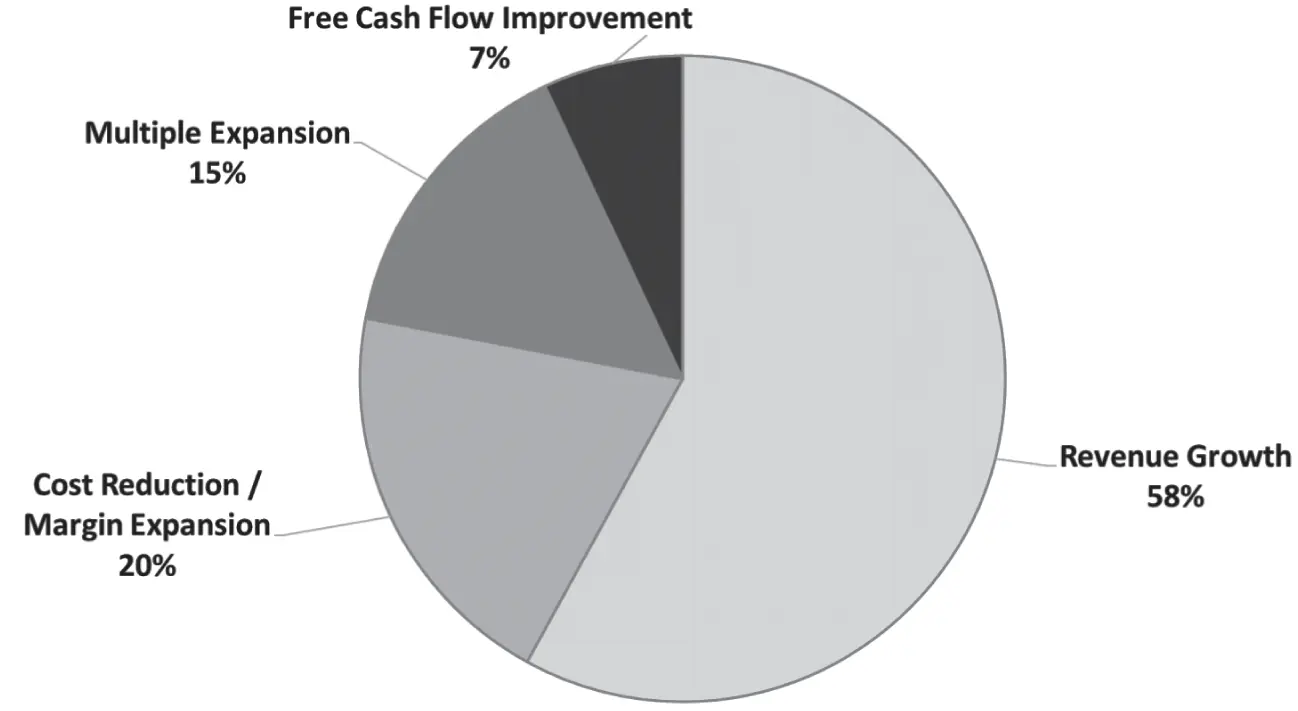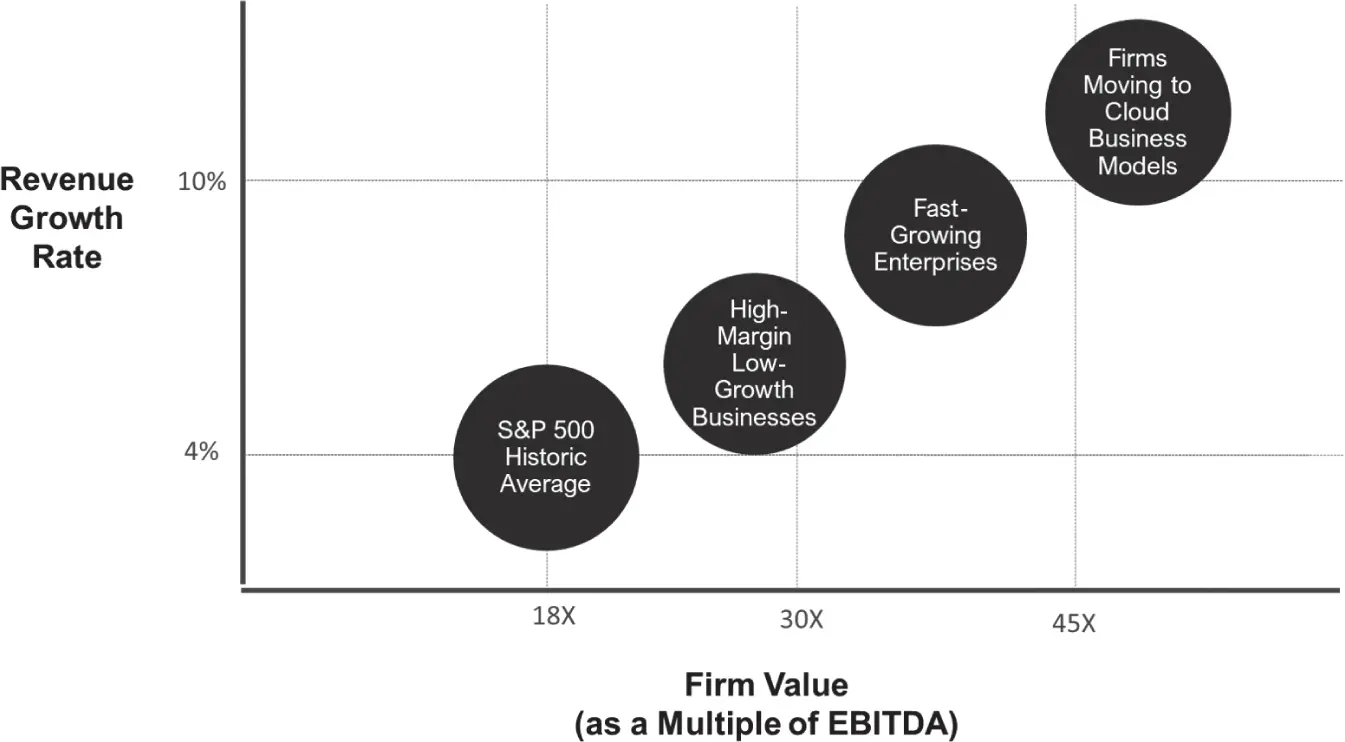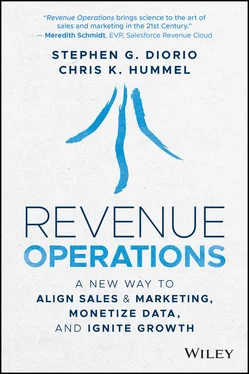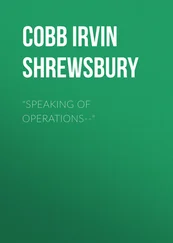Stephen Diorio - Revenue Operations
Здесь есть возможность читать онлайн «Stephen Diorio - Revenue Operations» — ознакомительный отрывок электронной книги совершенно бесплатно, а после прочтения отрывка купить полную версию. В некоторых случаях можно слушать аудио, скачать через торрент в формате fb2 и присутствует краткое содержание. Жанр: unrecognised, на английском языке. Описание произведения, (предисловие) а так же отзывы посетителей доступны на портале библиотеки ЛибКат.
- Название:Revenue Operations
- Автор:
- Жанр:
- Год:неизвестен
- ISBN:нет данных
- Рейтинг книги:3 / 5. Голосов: 1
-
Избранное:Добавить в избранное
- Отзывы:
-
Ваша оценка:
- 60
- 1
- 2
- 3
- 4
- 5
Revenue Operations: краткое содержание, описание и аннотация
Предлагаем к чтению аннотацию, описание, краткое содержание или предисловие (зависит от того, что написал сам автор книги «Revenue Operations»). Если вы не нашли необходимую информацию о книге — напишите в комментариях, мы постараемся отыскать её.
Revenue Operations: A New Way to Align Sales and Marketing, Monetize Data, and Ignite Growth
Revenue Operations
Revenue Operations
Revenue Operations — читать онлайн ознакомительный отрывок
Ниже представлен текст книги, разбитый по страницам. Система сохранения места последней прочитанной страницы, позволяет с удобством читать онлайн бесплатно книгу «Revenue Operations», без необходимости каждый раз заново искать на чём Вы остановились. Поставьте закладку, и сможете в любой момент перейти на страницу, на которой закончили чтение.
Интервал:
Закладка:
In addition, this book provides a career road map for any professional who seeks to advance their career and ultimately lead a business. It provides essential knowledge to any student who seeks a career in any growth discipline – marketing, sales, service, operations, or analytics.
Furthermore, the lessons and insights inside will help any business, from large enterprises to small companies, looking to accelerate growth.
How Is Revenue Operations a System for Growth?
At the simplest level, a system is a combination of things that work together as a united whole to achieve a common purpose .
Exactly what those “things” are, how they “work together,” the nature of the “united whole,” and the “common purpose” all define how any given system works. Systems can do many things: run a computer; educate people; manufacture and distribute products; and even manage money.
The “things” within a system can include a wide variety of ingredients – ranging from people and organizations to technology, devices, or software code to principles and procedures. The way they combine to “work together” can take the form of a machine (a computer), operation (manufacturing), a network (railroad), or a biologic process (digestion).
Businesses have established systems for most of their operations including: manufacturing, distribution, supply chain management, and finance. These systems are generally well organized, automated, managed, and measured in a mature organization.
The conversation changes when you start to talk about a system for growth. In most businesses, fragmented groups of customer-facing employees, silos of automation, and a lot of disconnected processes, policies, and technologies don't work well together. Nor do they work with a common purpose toward a common goal. There is no system to generate consistent, scalable, and profitable growth.
Revenue Operations changes that. It introduces new elements and shows how they work together. It offers a systems-based approach to growth across the entire revenue cycle: awareness, demand, purchase, and consumption (see Figure 1.1). Companies of all sizes and profiles can use it without having to rip the current business apart.

FIGURE 1.1The Revenue Cycle
The Financial Link Between Firm Value and Growth
An organization's ability to grow revenues has become more and more tied to firm value than at any time in our business lives.
This relationship can be seen in the high valuations awarded to businesses that can deliver predictable, scalable, and profitable growth. For example, the marketplace values firms with hyper growth (e.g. annual growth over 40%) and predictable revenues (e.g. Net Annual Recurring Revenues of over 100%) disproportionately. That is why a hyper-growth business like HubSpot commands price/earnings ratios in the hundreds while not yet showing a profit. It also explains why a SaaS business like Salesforce.comwith double-digit growth rates and recurring revenue streams will have a valuation in excess of 60 times its earnings – more than triple the S&P 500 average. 60
An analysis of total shareholder return of the S&P 500 over a 20-year span found that 58% of value creation is attributed to organic growth (see Figure 1.2). That means the ability to grow revenues organically has created more firm value than all efforts to reduce costs, expand earnings multiples, and improve free cash flow combined. 101
The capital markets value growth. Generating more consistent growth is a formula every business can use to create value. Private investors need growth to justify the historically high prices they are paying for businesses. Growth attracts talented employees, and buyers view it as a sign of innovation, quality, and validation.

FIGURE 1.2Sources of Shareholder Return. Source: Data from E. Olsen, F. Plaschke, D. Stelter, “Threading the Needle: Value Creation in a Low Growth Economy”

FIGURE 1.3Revenue Growth and Firm Value. Source: Blue Ridge Partners, Pitchbook, Blossom Street Ventures, Dow Jones, Refinitive 2021, Inc 500, NASDAQ
Today the average business in the S&P 500 is growing top-line revenues at 4% annually and is valued at 18 times earnings (see Figure 1.3). 52A firm that grows at double that pace is worth almost twice as much. Businesses that master scalable growth – by creating systems for growing revenues faster than the resources needed to generate those revenues – are even more valuable. For example, businesses that grow fast and have recurring revenue models are worth over forty times their profits. Companies like Google, Salesforce.com, or Citrix that have mastered the ability to scale revenues faster than costs are even more valuable. This is why so many private equity firms push their portfolio companies to move to a recurring revenue or cloud business model.
The growing importance of Revenue Operations as a practical way to create firm value is not lost on the owners and boards of high-growth businesses. Average purchase price multiples are at historic highs. PE investors are now paying in excess of 13 times EBITDA (which are earnings before interest, taxes, depreciation, and amortization) to acquire businesses. Most PE firms believe financial engineering will not be enough to justify such high prices and deliver their LPs the returns they expect. 60As evidence of this, over two-thirds (68.1%) of private equity firms are pushing their portfolio companies to grow at faster than 10% a year 58to justify the price premiums they have paid. 59Several private equity firms like Rockbridge Growth Equity, Morgan Stanley Private Equity, Tengram Partners, and Vista Equity Partners have created a growth culture, operating model, and infrastructure to support accelerated growth at scale across their portfolio. These growth-oriented investors have created centers of excellence in demand generation, call centers, and digital marketing channels. For example, Rockbridge is the private equity (PE) arm of the Quicken Loans group. They have been able to leverage their highly sophisticated marketing capability and focus on customer experiences that Quicken Loans used to become the #1 mortgage provider and launch Rocket Mortgage as a major brand across the other firms in the portfolio. Jim Howland, an Operating Partner at Morgan Stanley Private Equity, sees the role of the private equity investor evolving from pure financial engineering toward enabling faster revenue growth in the last few years. “What you do with an asset is as or more important as getting that asset at the right price,” reports Howland. “The reality is that if you want to attract good deals and make a return in today's PE world, you need to have a plan for how you will add value over the entire ownership period and build it into the price you pay for the asset. And a big part of that value plan is built around marketing and growth capabilities.” 103
Investment banker Ben Howe, CEO of AGC Partners, reinforces reports that Private Equity owners are increasingly creating value using a “buy, grow, and build” model of governance and enablement. “The top tech buyout funds including Vista, Thoma Bravo, and Insight are relentless in their programmatic efforts to build organically and apply operational best practices to enhance organic growth via ongoing technology, go-to-market initiatives and product improvements across the organization” reports Howe. “Stories like Vista taking Marketo private for $1.8 billion with ample leverage, growing it at 66% and then selling it to Adobe for $4.8 billion generating a multi-billion dollar return in just 2 years tends to get LP's attention.” 103
Читать дальшеИнтервал:
Закладка:
Похожие книги на «Revenue Operations»
Представляем Вашему вниманию похожие книги на «Revenue Operations» списком для выбора. Мы отобрали схожую по названию и смыслу литературу в надежде предоставить читателям больше вариантов отыскать новые, интересные, ещё непрочитанные произведения.
Обсуждение, отзывы о книге «Revenue Operations» и просто собственные мнения читателей. Оставьте ваши комментарии, напишите, что Вы думаете о произведении, его смысле или главных героях. Укажите что конкретно понравилось, а что нет, и почему Вы так считаете.











